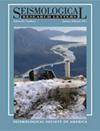Identification of Repeating Earthquakes: Controversy and Rectification
IF 2.6
3区 地球科学
Q2 GEOCHEMISTRY & GEOPHYSICS
引用次数: 0
Abstract
Repeating earthquakes (repeaters) are events that recurrently rupture the same fault patch with nearly identical magnitudes. Although repeaters have been widely studied and utilized in many fields over the last four decades, there are no standard criteria for reliably identifying such events. The current criteria adopted in the geophysical research community are inconsistent and difficult to justify. Different criteria may inescapably incur inadequate hypotheses and lead to controversial interpretations, highlighting the urgent need for seeking a uniform approach to reliably identify repeaters. In this study, we address this long-standing issue by deriving the most logical criteria on the basis of theoretical calculation with simple yet reasonable assumptions. Quantitatively, we define a repeating pair if their interevent distance is ≤80% of the rupture area of the larger event and their magnitude difference is ≤0.3. We demonstrate the superiority of our proposed approach with challenging cases in California, and our results shed new insight into the hierarchical fault structures in the source areas. Although this study focuses on defining repeating earthquakes, the application to repeating seismic events in other planetary bodies such as moonquakes and marsquakes is straightforward, potentially help avoid misinterpretations of the physical processes in both Earth and planetary interiors.重复地震的识别:争议与纠正
重复地震(中继器)是指以几乎相同的震级反复破坏同一断层带的事件。尽管在过去的四十年里,中继器在许多领域得到了广泛的研究和使用,但没有可靠识别此类事件的标准。地球物理研究界目前采用的标准不一致,难以证明其合理性。不同的标准可能不可避免地导致不充分的假设,并导致有争议的解释,这突出表明迫切需要寻求一种统一的方法来可靠地识别中继器。在这项研究中,我们通过简单合理的假设,在理论计算的基础上推导出最符合逻辑的标准,来解决这个长期存在的问题。从数量上讲,如果它们的事件间距离≤较大事件破裂面积的80%,并且它们的大小差≤0.3,我们定义了一个重复对。我们在加利福尼亚州的富有挑战性的案例中证明了我们提出的方法的优越性,我们的结果为源区的分层断层结构提供了新的见解。尽管这项研究侧重于定义重复地震,但将其应用于月球地震和火星地震等其他行星体中的重复地震事件是简单的,可能有助于避免对地球和行星内部物理过程的误解。
本文章由计算机程序翻译,如有差异,请以英文原文为准。
求助全文
约1分钟内获得全文
求助全文
来源期刊

Seismological Research Letters
地学-地球化学与地球物理
CiteScore
6.60
自引率
12.10%
发文量
239
审稿时长
3 months
期刊介绍:
Information not localized
 求助内容:
求助内容: 应助结果提醒方式:
应助结果提醒方式:


